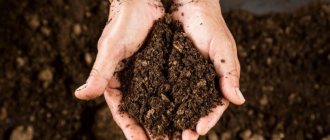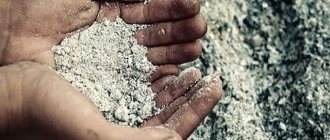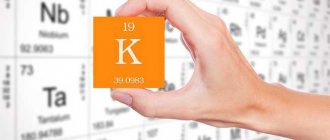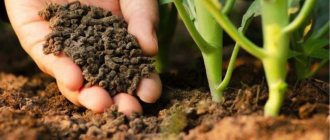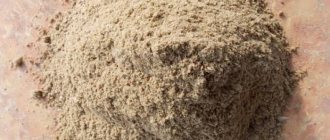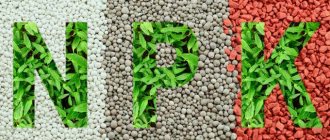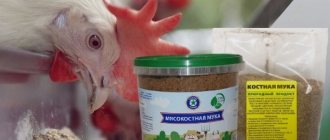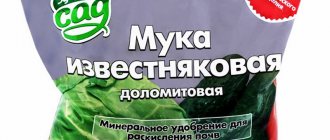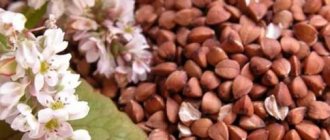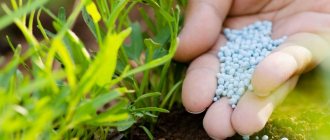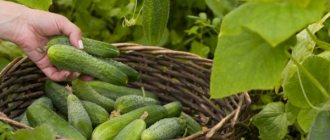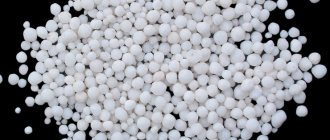Category: Organic fertilizers Reading time: 7 min · Views: 2,279
Bone meal has been used as an effective fertilizer for a long time. But lately they have undeservedly begun to forget about her. Perhaps this happened due to the rapid development of the chemical industry. However, this type of fertilizer has many advantages.
Description
Bone meal is an organic type of fertilizer that is considered safe. It is a product of processing the bones of birds and animals. The raw materials for its production are purchased from meat processing plants. It has the appearance of a light brown powder.
There are two ways to get it:
- Raw bones are crushed and ground to form a powder.
- The bones are boiled to extract fat, then they are steamed under pressure to extract glue. They are then ground to a powder.
Compound
Bone meal is a source of a large number of elements. Depending on the method of its production, it may contain from 15 to 23% phosphorus and calcium. The largest amount of phosphorus is found in low-fat products.
Today, this type of fertilizer is most often produced by the cooking method, so the nitrogen concentration in it is no more than three percent.
We advise you to read: Features of using dolomite flour in the vegetable garden, greenhouse and flower garden.
In addition, this product contains the following micro- and macroelements:
- Iron;
- Iodine;
- Copper;
- Cobalt;
- Manganese;
- Sodium;
- Magnesium;
- Potassium;
- Zinc;
- Manganese;
- Copper.
Bone meal for gardening is primarily a phosphorus fertilizer. Phosphorus helps strengthen the root system, improves flowering and contributes to a better harvest. And a large number of useful micro- and macroelements increase the immunity and resistance of plants to bacterial infections, pests and diseases.
Advantages
Concentrated fertilizer that does not require dilution. Considered safe and inexpensive. It is allowed to apply even a few weeks before harvest.
The use of bone meal as a fertilizer can significantly improve the composition of the soil after just six months. It becomes softer and more nourishing.
Bone meal has the following effects on plants:
- Plant growth is activated, they develop better;
- Productivity increases;
- Plant roots become stronger and develop better;
- Flowering improves;
- The use of bone powder has a positive effect on shoot growth and fruiting.
Soil enriched with bone meal allows the crop to avoid oversaturation with pesticides. Since phosphorus does not dissolve in water, the fertilizer is absorbed by plants slowly and gradually. And fertilizing remains effective throughout the entire growing season.
The advantages of this type of feeding include safety in case of possible overdose. This will not have any negative impact on the soil or plants. In addition, bone meal has no odor at all and does not require special storage space.
Bone meal should not be used to fertilize soil in which crops that prefer acidic soil will grow. This type of fertilizer can deoxidize the soil.
Effect of phosphonitrogen on plants, consequences of overdose
Bone meal for plants is a source of phosphorus and calcium. Six months after its application, the soil becomes soft and nutritious. The substances contained in bone fertilizer affect plants in the following way:
- seedlings take root faster;
- nitrogen activates growth and strengthens roots;
- the above-ground parts become greener and more massive;
- resistance to diseases and adverse environmental factors increases;
- flowering begins earlier;
- more ovaries are formed;
- the duration of fruiting increases;
- root vegetables accumulate starch and sugar and grow large;
- potassium and calcium improve the taste of fruits;
- productivity increases;
- vegetables and fruits are stored longer;
- lignification of shoots accelerates, which is very important for wintering perennials.
Tomatoes fed with phosphonitrogen have ripe flesh that is dense, uniform in color, and without white streaks. The harvest is ripening smoothly. Plants are less likely to be damaged by diseases and pests. Soil enriched with bone meal prevents the accumulation of pesticides in fruits that are harmful to health. Plants produce complete seed material that retains all varietal properties.
It is almost impossible to overfeed plants with bone meal. However, failure to comply with fertilizing norms leads to negative consequences:
- Large doses of bone meal alkalinize the soil. Plants stop growing because in such conditions nutrients are poorly absorbed.
- The use of fishmeal as a fertilizer together with a mineral complex leads to an excess of phosphorus in the soil. It prevents the roots from absorbing nitrogen.
- Adding stale produce to the soil causes the development of a fungal infection and the death of the crop.
- Fish bone meal is rich in nitrogen, an excess of which delays fruiting and increases the vulnerability of plants to disease and cold.
- Blood meal in large quantities causes burns.
Use of bone meal
Most often, bone meal is fertilized in the fall. The decomposition period of this fertilizer lasts about seven to eight months, which allows the nutrients to pass into a form convenient for absorption.
It is enough to apply once a year. However, some experienced gardeners believe that using bone meal once every three years is sufficient to maintain soil fertility.
Tomatoes
Growing vegetable crops requires more bone powder. Due to the calcium and potassium in the composition, this type of feeding will make tomatoes several times tastier. It can be applied when planting in spring or autumn. In this case, 50 grams of fertilizer should be placed in each hole.
Bone meal is also used in preparing tomato seedlings. It enhances root growth and also helps seedlings absorb nutrients such as nitrogen, calcium and potassium. This allows plants to more easily tolerate transplantation into open ground, as well as sudden temperature changes in the spring. Tomatoes begin flowering and fruiting earlier.
Potato
To grow potatoes, it is recommended to add bone meal during digging in the fall, since placing it in each hole takes too much time. Fertilizer is applied to potato fields and country beds in an amount of 300 to 500 g per square meter. This feeding promotes the accumulation of starch and sugars in the tubers, increasing their quantity and size.
Roses
For potatoes and roses, not only bone powder is suitable, but also fish meal, since it contains more nitrogen.
In order for roses to take root well, when planting, you need to add from 50 to 100 grams of bone meal to each hole. It is enough to fertilize adult bushes once every three years. To do this, it is necessary to apply fertilizer to the root zone in the same amount as when planting. Then the roots need to be mulched.
Strawberry
When preparing new beds for planting strawberries, bone meal can be added both to each hole and when digging the beds. In the second case, you will need 300 grams per square meter. And you should add 20-30 grams to the holes for each seedling. Adult plants will benefit from feeding during the flowering period or after fruiting.
Bulbous plants
Bone powder is often used for bulbous flowers, as it stimulates root growth and helps strengthen the bulbs. To do this, fertilizer in an amount of 20-30 grams is mixed with the soil. After this, the plant bulb can be planted in the hole.
Fruit trees and berry bushes
When planting berry bushes in a hole, you need to add 50-100 grams. Adult plants need fertilizer in the same amount every three years. This feeding is also useful for shrubs to restore strength after fruiting in preparation for winter.
Fruit trees are fertilized in large doses - 200-250 grams when replanting a tree, and also once every three years.
Houseplants
To prepare the soil that will be used for replanting indoor flowers, add one gram of bone powder per kilogram of soil. This ratio will facilitate easier adaptation of flowers to new conditions and will have a beneficial effect on flowering.
Recommendations from experts
Experienced gardeners and gardeners advise adding bone meal, taking into account the type of soil and crop. When using this fertilizer, you should follow the recommendations of specialists:
- Bone meal can be reapplied no earlier than after 20 days to avoid overdose. The minimum interval between uses of blood powder is 2 months.
- At the beginning of the growing season, plants require a lot of nitrogen, which is not enough in flour. Therefore, it is necessary to supplement the fertilizing with urea or ammonium nitrate. It is impossible to apply bone meal and nitrogen-containing fertilizers at the same time, since the active substances lose their potency due to pH differences. They turn into compounds that are inaccessible to the roots.
- Before using dry powder, the soil should be well moistened.
- The blood product contains little phosphorus and calcium, so it is better to mix it with bone product.
- Shell flour contains salt, so its use on clay soils is undesirable.
- Bone meal reduces soil acidity. Therefore, it is recommended to add it along with chalk or eggshells. Crops that prefer acidic soil cannot be fertilized with flour. The best effect is observed on alkaline soils.
- It is useful to introduce meat and bone waste into swampy soil to replenish it with copper.
- Phosphorus dissolves better in slightly acidic soil. Therefore, it is recommended to mix bone powder with peat, which has a low pH level.
- To prevent plants from experiencing a lack of potassium, which is low in bones, additional chicken manure is added.
- To increase efficiency, bone meal must be mixed with various useful components: ash or eggshells in a 2:1 ratio.
Important!
In the spring, organic fertilizer is applied when warm weather sets in and return frosts are no longer expected.
Liquid fertilizer
There is another option for using bone meal as a plant feed. To prepare liquid fertilizer you will need:
- Bone meal – 100 grams;
- Hot water - two liters;
- Cold - 4 buckets.
The flour is poured with hot water, the mixture must be kept for at least a week, stirring it regularly. After this, the mixture should be filtered and diluted with cold water in the amount of four buckets. Using liquid fertilizer a few weeks before harvest will make vegetables and berries much tastier.
Bone meal is a useful fertilizer with a rich composition, however, it should be supplemented. For example, when planting plants in spring, bone fertilizing alone is not enough, since at the very beginning of its life the plant requires a lot of nitrogen. Therefore, along with bone meal, you should add other organic fertilizers that are rich in nitrogen.
In what cases and how is it used?
Garden and vegetable plants are fertilized using the root method. Most often, bone meal is added to the soil in the fall in preparation for the next season. Fertilizer is scattered over the area in pinches (100-200 g per 1 m2), then digging is carried out. This option is preferable for fruit and berry plants, as well as perennial flowers. Autumn application will allow plants to better survive spring frosts and quickly adapt to weather conditions.
In greenhouses, bone meal is scattered over the surface, then embedded inside using a fork or bayonet shovel. Digging and turning the soil in greenhouses is not recommended, as the vital activity of microorganisms in the upper soil layer may be disrupted.
For vegetables, it is advisable to add flour in the spring directly to the hole before planting the seedlings. Fertilizer is poured into the hole, lightly mixed with soil, then the plant is planted. The general consumption rate is 1 tbsp. for 1 planting hole.
It is also permissible to use bone meal during the growing season of plants. The liquid form (water + flour) is used to water young seedlings or indoor plants. The procedure is carried out 1-2 times per season. House flowers are also watered no more than 1-2 times a year. At the end of summer or early autumn, a pinch of bone meal can be added to the holes for watering fading and stunted plants. Fertilizer will slightly extend the growing season.
Another variation of use is adding to compost or manure. It is best to use blood meal in this case. The goal is to accelerate decomposition and enhance the activity of microorganisms.
Homemade bone meal
You can make this fertilizer yourself. It is best to use beef bones for this.
Manufacturing process:
- First you need to clean the bones from any remaining fat and meat, then boil them for two hours.
- Then bake the bones so that they become brittle at a temperature of 200 degrees.
- After they have cooled completely, they need to be placed in a fabric bag and crushed as finely as possible with a hammer. It is advisable to grind them to a powder state.
- Place the finished product in cloth or paper bags and store in a cool and dry place.
Varieties
The name “bone meal” also refers to all organic fertilizers that are made from the tissues of animals and fish.
Fish flour
It is made from soft tissues and bones of various types of fish. This fertilizer contains a lot of phosphorus - about 16%. It also has a high protein content, which makes it possible to use fishmeal as a feed additive in livestock farming.
Horn shavings
Horn shavings or horn-hoof meal are a type of bone meal made from horns and hooves. It has a high nitrogen content, about 10%. Unlike bone and fish meal, it is used as a top dressing every season.
Blood meal
This type of organic fertilizer has the highest concentration of nitrogen (13%), which can significantly stimulate the growth of green mass. The content of phosphorus and potassium in blood meal is low. For this reason, it must be mixed with regular bone meal to achieve greater effectiveness.
The dosage should not be exceeded, as this may have a detrimental effect on the plants.
Blood meal can change the acidity of the soil, as it has an increased concentration of nitrogen. Therefore, it is better to use it to fertilize soil with a high alkali content, which will ensure balance.
Pantsirnaya
This exotic species is widely used in southern countries. It is made from the shells of crustaceans, which are ground into powder.
Bone meal is a useful organic and safe fertilizer that contains a large amount of useful substances. It allows you to strengthen the plants and get a better, larger and tastier harvest.
Manufacturing methods
The retail chain provides a wide range of bone and fish meal obtained from processing industry waste in packages of various capacities.
If necessary, you can select the product that is more suitable for the application conditions. This approach is suitable for mass use. When it comes to pets or plants, some DIY enthusiasts prefer to make this product themselves .
Therefore, two manufacturing options are being considered: industrial and artisanal methods. The result of artisanal technology can be a higher quality product due to the use of higher quality, selected raw materials for the manufacture. This is exactly what lovers of self-production are striving for.
Industrial
The raw materials for obtaining bone meal, as noted above, are waste from meat and fish processing plants and the slaughter of sick animals prohibited for use as food for humans. The technology for producing oatmeal from meat and bone material under production conditions includes the following operations:
- incoming control of raw materials in the veterinary laboratory;
- crushing of the first stage to ensure the preparatory stages of processing;
- drying of crushed material in drying units and subsequent digestion of the intermediate product;
- secondary grinding of the raw material to the state of homogeneous minced meat;
- dehydration and defatting of the minced mass is carried out using a centrifuge or separator and a bone concentrate is obtained - an emulsion consisting of water and fat;
- final drying of the resulting concentrate and bringing it to a powder state with a final grinder.
The finished product in the form of bone meal is packaged in bags and sent to consumers. The product can be stored for no more than six months without loss of quality.
artisanal
The product can be made in small quantities at home. The raw materials for cooking are, in fact, waste, and therefore the smell from it may be special, not entirely pleasant. So the best way to make your own bone meal is outdoors.
The cooking technology can be different, but it comes down to two main stages: first, soften and dry the bones, and then grind them using some kitchen appliances like a meat grinder or coffee grinder to a powder mass. To combine the processes of softening and drying bones, they are roasted over a fire. After the first layer of firewood has burned, bones from large animals or birds are laid on the coals, fish bones - separately or in a mixture. Firewood is again placed on top and burned; if the bones have not become softer, the procedure is repeated. Having achieved softening, the burnt bones must be collected in a clean container.
You can grind the prepared seeds either manually in a mortar or using kitchen equipment - a blender, coffee grinder, grain grinder or grain crusher . The usefulness of finished bone meal can be increased if eggshells or meat are added to the raw materials during the grinding process.
This technology will not allow the production of large quantities of the product. To increase the volume of production with your own hands, you will need to purchase more powerful and productive grinding equipment.
